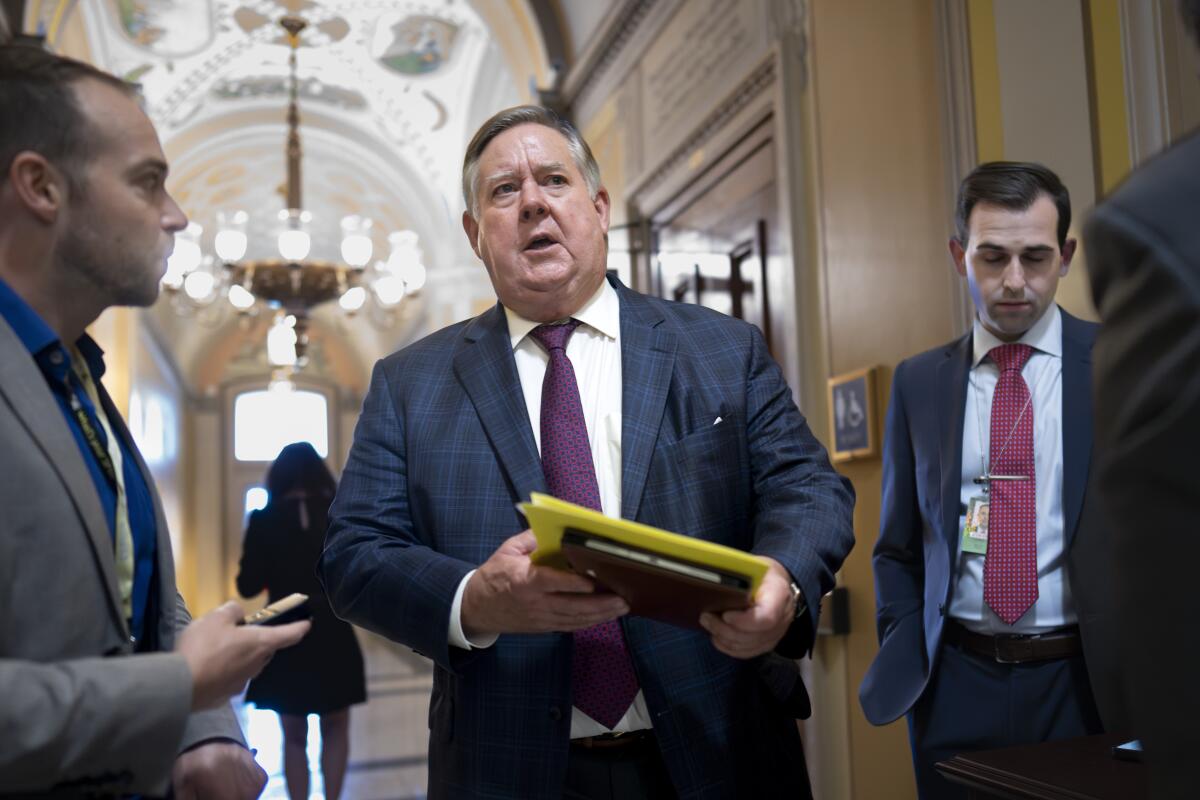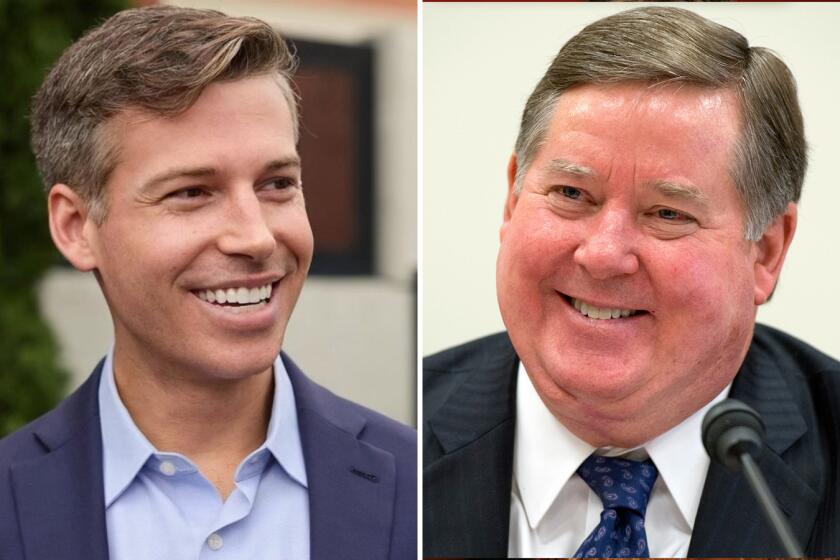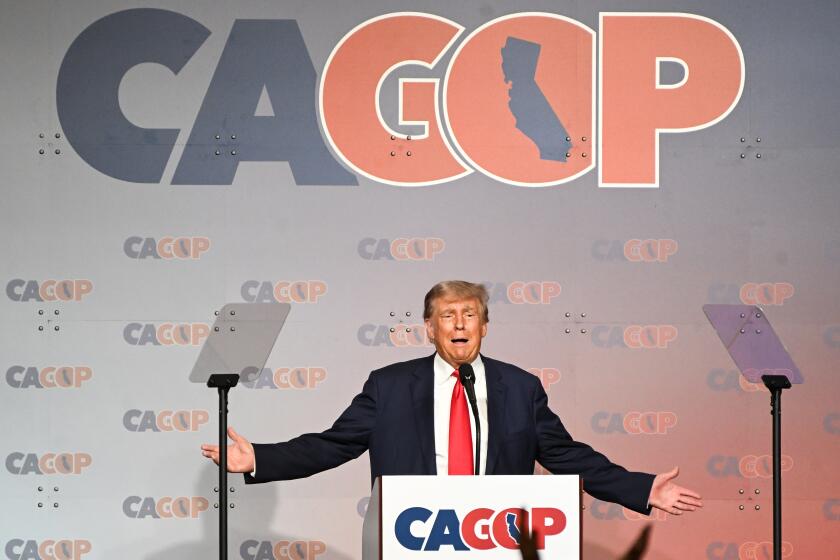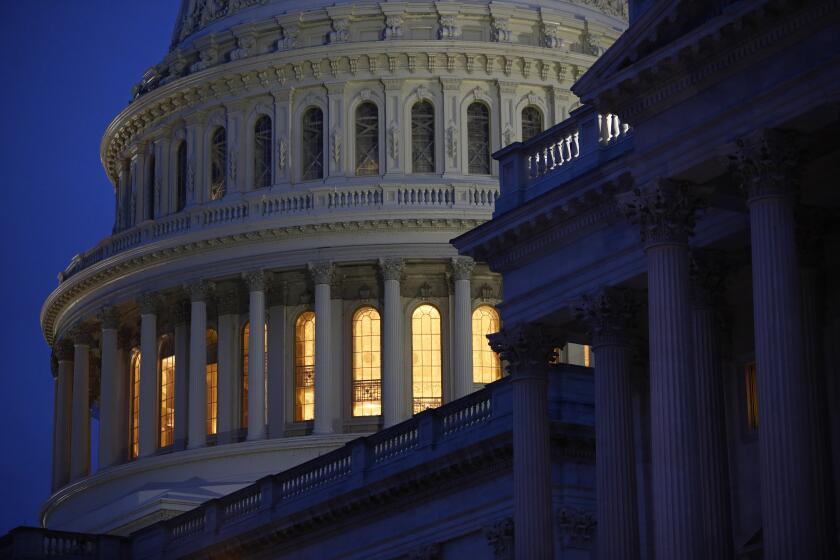Rep. Ken Calvert has secured millions for his Riverside County district. Do his own properties benefit?

- Share via
Since Congress brought back the legislative process known as earmarking in 2022, few lawmakers have been as successful at securing funds for their district as Rep. Ken Calvert.
Calvert, who has been in Congress longer than any other California Republican, has funneled more than $100 million since then into projects in his Riverside County district.
The earmarks, which are line items inserted by members of Congress into federal spending bills, include $9 million to smooth out bottlenecks and add toll lanes along Interstate 15, $2 million to widen a traffic-choked bridge in Corona and $5 million for a planned rail line between Los Angeles and Palm Springs.
Those $16 million in planned improvements fall within several miles of rental properties that Calvert owns, raising questions about the extent to which he personally benefits from the earmarks he’s secured.
Calvert’s real estate portfolio includes 10 commercial rental properties in the Corona area, 20 acres of land in Riverside County, two properties in Arizona and his residences in Corona and Washington. His California properties are valued at as much as $26 million and generated between $320,000 to $805,000 in rental income for Calvert last year, according to his financial disclosures.
Calvert owns most of the properties jointly with business partners. They include an automotive repair center, self-storage facilities and strip malls in Corona’s downtown and in a nearby light industrial area.
Calvert, 71, said the projects he’s funded through earmarks originate with requests from local government agencies. He said he doesn’t consider his rental properties, or how he would personally benefit, when choosing which projects to support with federal taxpayer funds.
“If I wanted to make money,” Calvert said, “I wouldn’t have ran for Congress.”
In a district that sprawls from the Inland Empire into the Coachella Valley, Democratic challenger Will Rollins is hoping to unseat longtime GOP Rep. Ken Calvert.
Calvert, an experienced real estate investor, was first elected to the House of Representatives in 1992. He has not reported any property sales since Congress revived the earmarking process.
“I enjoy investing,” Calvert said. “They haven’t made it illegal to invest. Real estate is something I know, and I get a little bit of income. ... I don’t think there’s anything wrong with that.”
Questions over his real estate deals have resurfaced as Calvert faces a reelection fight against Democrat Will Rollins. Calvert beat Rollins, a former federal prosecutor, two years ago. But the race was tighter than expected, driven in part by redistricting, which in 2022 swapped some reliably conservative areas in the 41st Congressional District for more liberal ones, including Palm Springs.
Rollins, who previously prosecuted national security cases for the Justice Department, has taken aim at Calvert’s history of real estate deals in his home district. Calvert, he said, is proving the “widespread perception that people go to Congress to become rich.”
A review of Calvert’s financial records also show that the congressman failed to disclose the purchase of a commercial rental property in Corona in 2016.
Starting in 2021, however, Calvert did report earning between $15,000 and $50,000 a year in rental income from the property on East 6th Street, which houses auto-body shops and smog-check stations. The property sits about a mile from a bridge in Corona that received $2 million in earmarked funds through Calvert’s office.
Jason Gagnon, a spokesman for Calvert, said the building was purchased for $2.25 million in September 2016 and Calvert’s 11% investment stake was valued at $247,000.
He has earmarked funds for Riverside County projects near properties he sold for a profit.
Calvert said he bought the building with his brothers in 2016 after selling property left to them by their late mother. The building was “in pretty bad shape,” he said, and needed a new roof and parking lot. He said it was not fit to be rented out for several years.
In response to questions from The Times, Calvert said he would file an amended financial disclosure.
Calvert defends use of earmarks
Investment properties are relatively common in Congress, experts say, but having a real estate portfolio in your home district can raise a host of ethical quandaries.
Lawmakers are barred from using their offices to enrich themselves. But members of Congress are generally allowed to push for earmarks “that provide a benefit to the general community, even though they might personally benefit from them,” said Brett Kappel, a lawyer who has advised Republicans and Democrats on government ethics and campaign finance.
Noah Bookbinder, the president of the government watchdog group Citizens for Responsibility and Ethics in Washington, said it seems “pretty unlikely” that Calvert violated any of Congress’ “pretty loose, and pretty permissive” conflict-of-interest laws.
“It gets tougher when you think about the appearance of a conflict,” Bookbinder said. “If you have significant income coming from rental properties which could be affected by your decisions, it raises a question of what’s motivating you.”
Calvert said earmarks are a key way to secure funding for the Inland Empire, which he said has been “kind of a stepchild” compared with California’s larger, urban areas.
Rollins said he, too, supports earmarks, but worries the process is ripe for abuse. He said he would support legislation requiring lawmakers to place their assets in a blind trust, and said he would support jail time for members of Congress who fail to disclose their assets.
Similar bills have gone nowhere in recent years in Congress — a sign, Rollins said, that the lack of appetite for ethics reforms is a “bipartisan problem.”
What do Republican congressional candidates have to say about Donald Trump’s conviction? Those in competitive districts mostly say nothing.
Congress banned earmarks in 2011 after a series of high-profile scandals, including the infamous “bridge to nowhere” project in Alaska and several lawmakers who ran into legal trouble after steering funds to their districts.
That included former Rep. Randy “Duke” Cunningham (R-Rancho Santa Fe), who in 2005 pleaded guilty to accepting $2.4 million in bribes from military contractors in exchange for steering contracts and funds to their projects.
Calvert came under scrutiny in the same era, along with Inland Empire Rep. Gary Miller and former House Speaker Dennis Hastert (R-Illinois), for profits they reported from real estate deals near projects funded through congressional earmarks.
In 2005, Calvert and a business partner bought a vacant 4.3-acre lot near an Air Force base in Riverside County for $550,000. In August 2005, President George W. Bush signed a highway bill that included $8 million to build an interchange with Interstate 15, and $1.5 million to support commercial development of the area around the airfield.
Calvert and his partner sold the land several months later for $985,000, a 79% profit. Calvert told The Times at the time that people were “trying to manufacture controversy, even where there isn’t any,” and that he had done nothing illegal.
After President Obama said he would veto any legislation that contained earmarks, Congress voted to temporarily ban the practice in 2011. Calvert supported that ban, and also voted a decade later to lift the moratorium.
There are now tighter rules around earmarks: Lawmakers must now disclose their appropriations requests online and show that they have community support. Republicans, who control the House, have also limited each lawmaker to 15 earmark requests.
It’s too early to say whether the reforms have helped to clean up the earmarking process, said Kedric Payne, the senior director of ethics at the Campaign Legal Center, and a former deputy chief counsel at the Office of Congressional Ethics. The question, he said, is whether Congress is “going down the path to the same problems we were trying to avoid the last time.”
Proposed bridges, toll lanes near investment properties
Calvert is still among the House’s most successful earmarkers. In the last fiscal year, Calvert secured nearly $44 million for his district, the 24th highest in the House, according to a Times analysis of federal spending bills. He was surpassed by three other members of the California delegation: Rep. Darrell Issa (R-Vista), Rep. David Valadao (R-Hanford) and Rep. Zoe Lofgren (D-San Jose).
Calvert said he meets annually with cities across his district and encourages government agencies to submit earmark applications. His office received 35 requests in the 2024 fiscal year and 37 in the 2025 fiscal year, Gagnon said.
Calvert has mostly prioritized projects designed to address traffic congestion.
That includes $2 million toward widening a bridge along Magnolia Avenue that connects downtown Corona to a light-industrial area to the east. A study commissioned by the city found that widening the bridge from four lanes to six lanes would stave off some of the worst traffic delays for the next two decades, but that overall, traffic will continue to get worse as the population grows. The $17.5-million project is tentatively slated to be finished in 2027, the city of Corona said.
Calvert owns half a dozen properties within two miles of the bridge, including the automotive repair center, a strip of office suites and a self-storage facility.
From the farm towns of the Central Valley to the beaches of Orange County, California is a battleground for control of the House of Representatives.
Calvert also secured $3 million for the addition of toll lanes in the center of Interstate 15 that will extend nearly 15 miles through Corona, El Cerrito and Temescal Valley. The northernmost point of the project is about four miles south of Calvert’s rental properties.
The toll lane project, a possible release valve for some of the Inland Empire’s infamous traffic congestion, is “probably one of the No. 1 things that people wanted,” Calvert said.
The toll lane project could cost as much as $650 million, said David Knudsen, a deputy executive director of the Riverside County Transportation Commission, the agency that requested the earmark.
A nearby intersection with Interstate 15 has received $6 million over two years in earmark funding to untangle vehicle, pedestrian and bicycle traffic.
The RCTC also received $5 million through federal appropriations to help pay for the environmental study for a rail line between downtown L.A. and Palm Springs. The project would use existing Metrolink right-of-way between L.A. and downtown Riverside and would add new tracks in the Coachella Valley, Knudsen said.
The routes and stops haven’t been decided yet, but one of the two Metrolink lines running between L.A. and Riverside stops in downtown Corona a few blocks from several of Calvert’s properties.
Calvert said he supported the project in part because of its potential for freight use overnight. He said when passenger service isn’t running, the line could be used to carry cargo from the ports of Los Angeles and Long Beach to distribution centers in the Inland Empire, reducing truck traffic and emissions.
The $1.5-billion rail line is a “huge project,” Knudsen said, that’s still in the distant future. The study alone will take five years to a decade to complete, he said.
More to Read
Get the L.A. Times Politics newsletter
Deeply reported insights into legislation, politics and policy from Sacramento, Washington and beyond. In your inbox twice per week.
You may occasionally receive promotional content from the Los Angeles Times.













